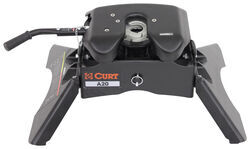
How Does Sidewinder 5th Wheel Clearance Work if Fifth Wheel Front Corners Are Dished In
Question:
Is the value of Cinch in your formula using a square nosed 5th wheel trailer only? If the nose has a curvature, the total width lowers and the factor for Cinch is different. This is critical to know when ing how much travel is needed in a Slider hitch.
asked by: Rob K
Helpful Expert Reply:
The clearance formula assumes that the fifth wheel uses a square nose. If the corners are curved or dished out, the number of inches that the corners are recessed at 42-44 inches left and right of the center of the front of the 5th wheel would be added to the amount of clearance you end up with once you work through the formula.
So, the formula would then work like this:
(A + B) - C = Clearance + Number of Inches corners of 5th wheel are dished in compared to the center of the nose.
If you find that the sliding hitch wouldn't provide enough clearance, you could consider a Sidewinder which changes the pivot point between the 5th wheel and the hitch from the point where the king pin sits in the hitch jaws 22 inches rearward to where the pin box attaches to the fifth wheel. The article I've linked you to explains in detail how a Sidewinder works, and also shows which Sidewinder models are compatible with which OEM pin boxes.
A = Distance from center of fifth wheel hitch jaw to truck cab
B = Length of Sidewinder arm (22 inches)
C = Width of trailer divided by 2 (to get half)
The number of inches that the nose corners are dished, recessed, curved at 42-44 inches left/right of center when compared to the middle of the nose would be added to the amount of clearance. This works because that particular spot would come closest to the truck cab corners during turns.

Product Page this Question was Asked From
Curt A20 5th Wheel Trailer Hitch - Dual Jaw - 20,000 lbs
- Fifth Wheel Hitch
- Fixed Fifth Wheel
- Above Bed Rails
- 5000 lbs Vertical Load
- 20000 lbs GTW
- Cushioned Double Pivot
- Standard - Double Jaw
- 13 - 17 Inch Tall
- CURT
more information >
Featured Help Information
Instructions
Miscellaneous Media

Continue Researching
- Q&A: Which 5th Wheel Hitch Will Work With My OEM Pucks and a Rotating Pin Box
- Article: 4 Steps to Choosing Your 5th Wheel Pin Box
- Article: Guide to Choosing the Best Truck for 5th-Wheel Towing
- Q&A: Which Is Better, The Curt A-Series Or Q-Series Fifth Wheel Hitches
- Q&A: Does Truck with 6-1/2 Foot Bed Need a Slider Hitch
- Article: Gooseneck to 5th Wheel Adapters
- Q&A: Comparing the Curt Q20 and the Curt A20 5th Wheel Hitches.
- Article: Ram Trailer Tow Prep Package
- Article: Sidewinder with Rotating Turret for Short Bed Pickups
- Q&A: How to Adjust Curt A20 Hitch Head Height for Trailer that has Front Tires Showing Wear
- Q&A: Comparing Curt A20 and Curt Q20 5th Wheel Hitch for 2020 GMC Sierra 3500
- Q&A: Comparing B&W Patriot and Curt A20 Fifth Wheel Hitches
- Article: The Best 5th Wheel Hitches
- Article: Trailer Wiring Diagrams





